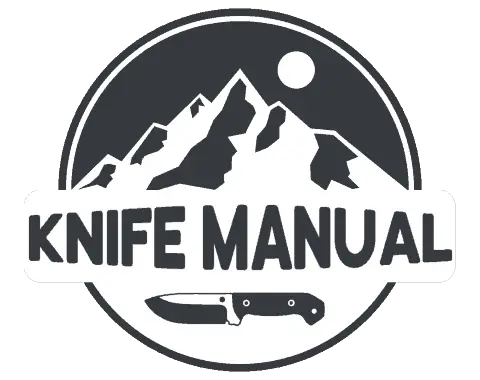Let’s just face it, there are a TON of different handle material options for knives out there. But which one is truly the best for a survival knife?
The quick and easy way out of this question would be to simply say that it depends on your needs and what you prefer. And that is a completely valid point, but why not look at all the different materials and find which would truly be the best for a knife intended for use in survival and bushcraft situations.
In general, the best handle material for a survival knife would be modern synthetic nylon, dense rubber, or other material like that. Knife handles made from these sorts of materials will last for a long time even in extreme conditions, and will make for an all-around durable tool.
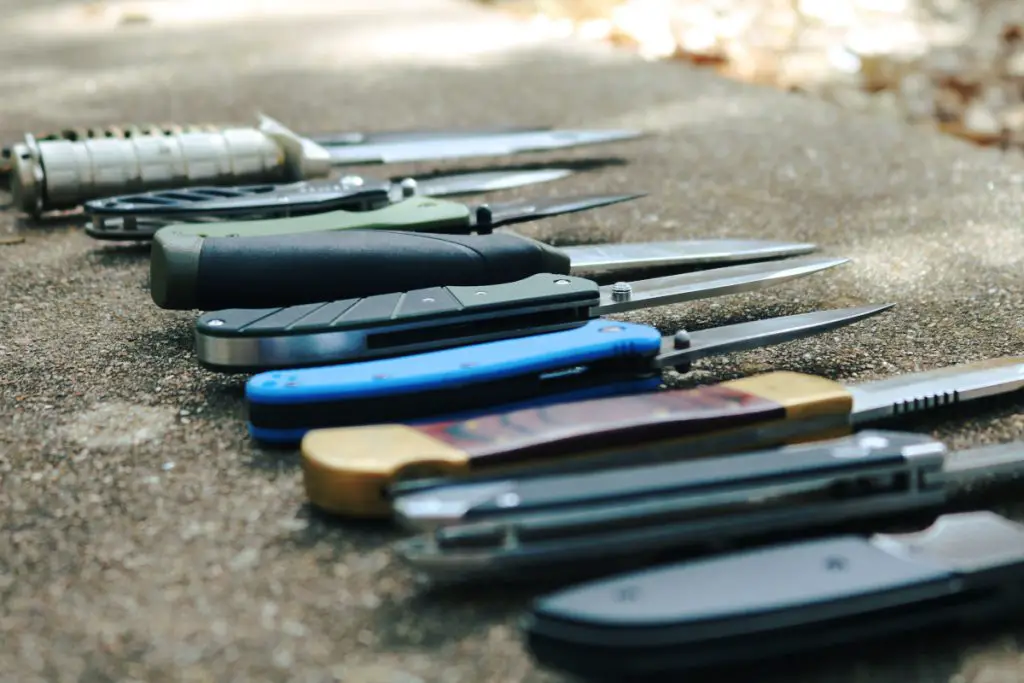
Table of Contents
Main Criteria for a Survival Knife Handle Material
The main criteria that I have for a survival knife in terms of its handle are listed below. From most important to least important.
- Durability
- Grip
- Feel
- Beauty
Durability
Why this criterion is at the top of the list is no accident. The need for a durable handle material on a knife, especially a survival knife, cannot be stressed enough. The decision to get a durable handle material will save you hours of worrying and frustration.
When you are having to work with your knife in the wilderness where nature is at its strongest, the last thing you need to be worried about is your handle’s durability. This might not be apparent at first, but trust me, as soon as your knife gets a couple of years old and it starts to show some wear, you’ll be glad you picked a durable handle material.
Not only will you eliminate the stress of wondering if your knife is going to fall apart in extreme conditions, but choosing a durable knife handle material will also improve the knife’s lifespan even in everyday use. This criteria is less short-term and more looking at the overall life of the knife and its usage in its later years.
Grip
A large part of actually using a knife is holding on to and tightly gripping the handle. If the material chosen for the handle of the knife is smooth and slick, you’ll have a hard time effectively using your survival knife.
Especially in survival and wilderness situations where a survival knife is intended to be used, the situations and environments in which you would be operating in would most likely be less than ideal and pleasant. The need for a grippy handle is magnified and almost non-negotiable in these situations.
So if you intend to use a survival knife in a survival situation. (Which is the whole reason that you would want to get a survival knife in the first place.) You need a grippy and easy to hold handle. It’s what makes a survival knife a survival knife instead of a kitchen knife.
Feel
It’s no fun to use a knife that has a scratchy or otherwise unpleasant to hold handle. This fact does not change in any way for survival knives. This criteria that I have for a survival knife is very important because it either invites you to use your knife or makes you dread pulling it out of its sheath.
When the situation you are in is difficult and unpleasant, the last thing you need is the handle of your knife hurting your hand or making it uncomfortable. Just eliminate this problem from the start and make sure the handle of your knife is comfortable to hold.
This aspect of a survival knife handle also goes far beyond just how comfortable the handle is to hold. It could improve your abilities to complete tasks and techniques with your knife.
Many tasks you will need to complete in a survival situation with your knife will require skill, precision, and agility. A comfortable handle allows you to easily maneuver your knife to more easily complete whatever it is that needs to be done.
Beauty
Last but not least, aesthetics and beauty. While it is far from the most important aspect of a survival knife, it’s always nice to have your tools look nice. You should never choose a survival knife based solely on the beauty of its handle, but there is nothing wrong with choosing a survival knife that meets all the other criteria but also looks nice.
Many first-time survival knife buyers get caught up on this criterion and take it too far. I even struggle to call it a criterion in the first place. After all, a survival knife would still serve its purpose regardless of whether it looks ugly or pretty. As long as it meets all the other requirements, the beauty of a knife handle is significantly less important to the overall function of the knife in a survival situation.
Metal Knife Handles
The category “Metal Knife Handle” is a rather broad one that holds a great number of different options that all have their own particular set of strengths and weaknesses. Below I will introduce you to a few of the many options available. This is not an extensive list of all the metals used to make knife handles, just a few of the more popular and best metals used.
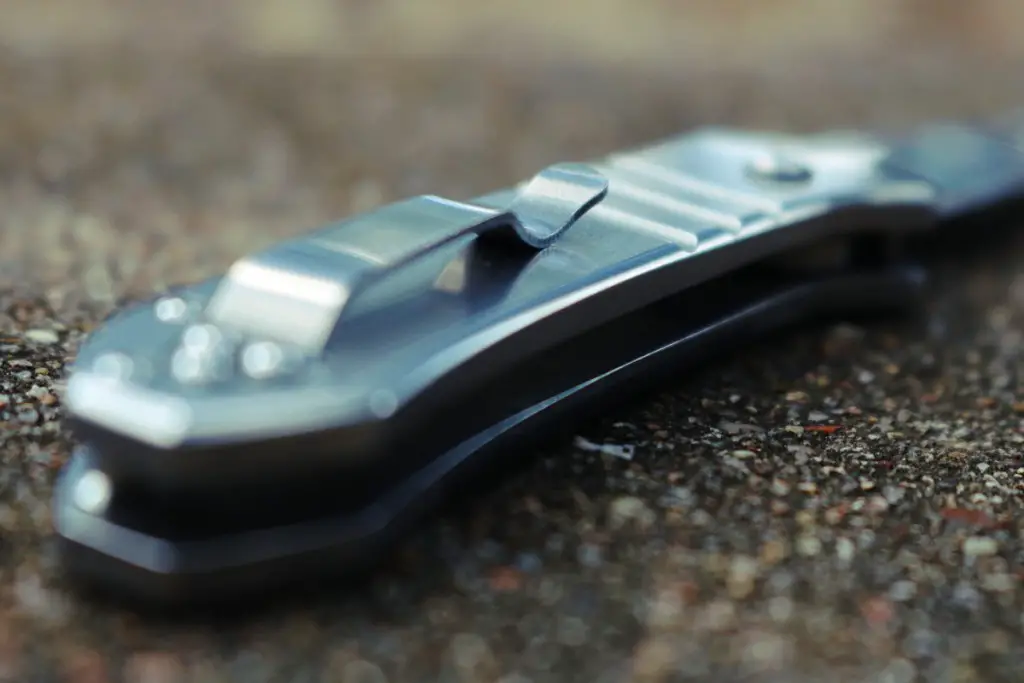
Stainless Steel
- Durability: 8/10
- Grip: 5/10
- Feel: 6/10
- Beauty: 7/10
Out of all the metal material handle options for survival knives, stainless steel is one of the most common and for good reason. Stainless steel is very resistant to scratches, dents, and corrosion. It is, however, not immune to these sorts of things. Just better and more resistant than other materials.
In cold climates, stainless steel holds the temperature and can be unpleasantly cold to pickup. While this might not be a particular problem if the stainless steel handle is coated in a different material to improve the grip, it is still something to be aware of and keep in mind.
The major downside to stainless steel handles on knives is the weight. While it isn’t super heavy, stainless steel is an overall dense metal that might take some getting used to if you are carrying your knife around wherever you go.
Some of the most common and best stainless steels that I have seen used on knife handles are 410, 416, and 420. Overall, this is a great, durable option for a knife handle as long as you can look past the added weight that stainless steel brings.
Aluminum
- Durability: 7/10
- Grip: 7/10
- Feel: 8/10
- Beauty: 9/10
Aluminum is almost the exact opposite of stainless steel in regards to how they perform as knife handle materials. Aluminum is a less dense metal, leading to the added probability of it holding and taking dents and scratches more easily. The upside to this is that it is generally lighter due to aluminum being a low-density metal. However, it does share a very nice trait with stainless steel: it is resistant to corrosion for the most part.
While there are many different ones, the most common aluminum alloy used in knife handles is T6-606. Aluminum allows for a metal knife handle to be light and portable, while also being very sturdy and corrosion-resistant.
Another smaller factor to consider is how aluminum holds temperature. Aluminum tends to hold coldness very well, even when it is not extremely cold outside. This might not be that big of an issue but can become very uncomfortable if used for a long time.
An added benefit of aluminum knife handles is that they can be anodized (a finishing process on the metal) and turned almost any color. This makes them highly customizable, unique, and very beautiful. Aluminum checks all of the boxes of a good survival knife except the durability criterion. It’s not as though it will fall apart and rot away in your hand, points are taken off in this category because of aluminum’s susceptibility to scratches and dents.
Titanium
- Durability: 9/10
- Grip: 8/10
- Feel: 9/10
- Beauty: 9/10
Top of the line and quite expensive at times, titanium is a really good choice for a knife handle if the price doesn’t bother you. Titanium is extremely corrosion resistant and quite durable and strong, although not quite as scratch-resistant as stainless steel. It will hold and get scratches and dents almost as much as aluminum but its overall strength as a knife handle is great and outweighs the downside to this in many cases.
The major factor that makes up for its susceptibility to scratches and dents as well as the price, is its weight. While a fraction heavier than aluminum, titanium is a bunch stronger overall. It is far from indestructible but is much stronger than both stainless steel and aluminum.
Unfortunately, cheap alloys of titanium are commonly used as knife handles and blades that while they say “titanium” do not carry the full strength that high-quality titanium would have. The most common of these cheap titanium alloys is 6AL4V. A high-quality titanium alloy that will hold up and be very durable is Ti6Al4V.
Another thing to point out is how titanium holds the surrounding temperature of its environment. Titanium is one of the few metals that in most cases tend to be very neutral in temperature. It does not hold a certain temperature super well, it just seems to be at room temperature all the time. It also has a certain “springy” quality to it while also being and feeling very sturdy.
Just like aluminum, titanium can be anodized and finished beautifully. This added benefit plus all of the previously mentioned good qualities make aluminum one of the best metal knife handle options for survival knives. The only thing that is a major problem with titanium is the price. You tend to get what you pay for, and if you’re able to spend the extra money to get a titanium knife handle, you will be pleasantly surprised with the durability and performance it provides.
Synthetic Knife Handles
While synthetic materials might be slightly inferior to metals concerning overall durability, they are a solid choice for a knife handle because they are specifically designed and engineered for the job.
They are often light, waterproof, and very grippy which makes them score high on the criteria list for survival knife handle materials. The other nice thing about synthetic knife handles is that they fo not rust one bit! And if for some reason you do not like the qualities of particular synthetic material, lucky for you, there are hundreds of different ones to choose from.
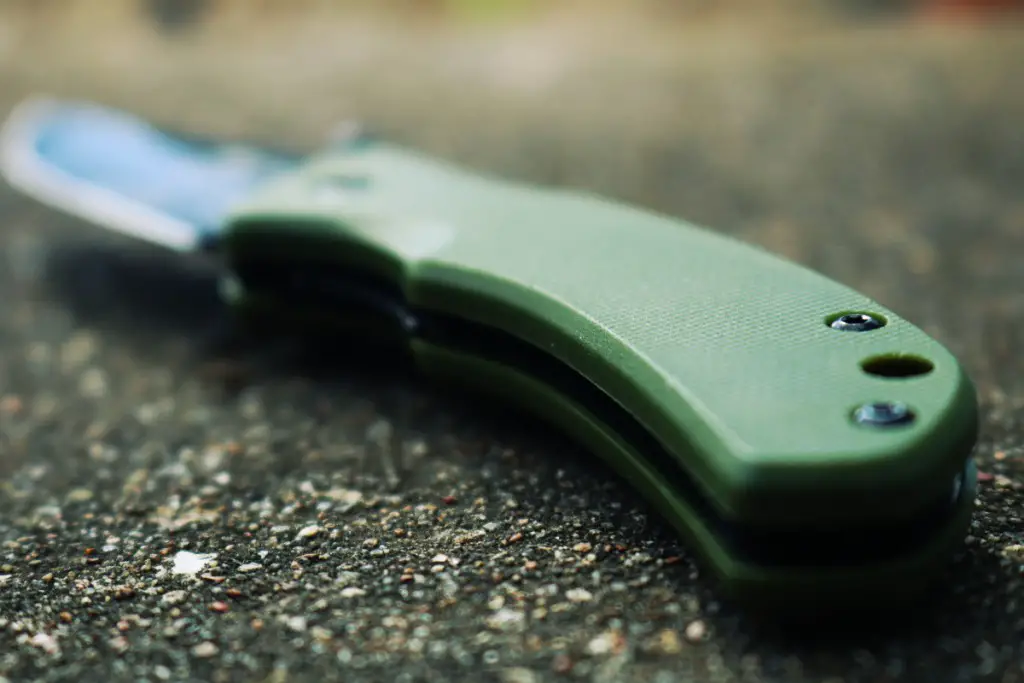
G-10
- Durability: 8/10
- Grip: 8/10
- Feel: 8/10
- Beauty: 5/10
G-10 is a very popular knife handle material, especially among survivalists and outdoorsmen. While commonly known as G-10, it’s a fiberglass composite laminate that is made by fiberglass strips that are soaked in resin before being pressed together into a very durable, light, and solid material.
While inherently not very grippy, G-10 can be textured so that it feels nice in your hand and won’t easily slip while you are using your knife. Overall, G-10 is a very durable knife handle material, although, because it is made of fiberglass it can be quite brittle and not fare very well upon heavy impact.
The major downside to this material is the brittleness, but also its beauty is a drawback. While not the worst looking material out there, G-10 lacks the elegance and appeal of other materials. Otherwise, if you’re not going to be throwing your knife around and the beauty of it is not a top priority, G-10 is a very solid choice for your next survival knife handle.
Carbon Fiber
- Durability: 8/10
- Grip: 7/10
- Feel: 8/10
- Beauty: 9/10
The word “carbon fiber” is a very broad category and encompasses a huge number of synthetic materials. Carbon fiber is made by taking strips of carbon and weaving them together before soaking them in resin. The result is a very strong and beautify material that is very expensive and desirable.
While overall carbon fiber is strong, just like most synthetic knife materials it does not handle impact and pressure very well. Carbon fiber most likely won’t break when used normally or stressed in a single direction, but as soon as it is stressed in multiple directions or suffers impact into something very hard it has the possibility of cracking or shattering. The main problem with carbon fiber, besides the brittleness, is the price. You will pay a premium price for premium material.
The upside to this material is it is super lightweight. Its strength to weight ratio is amazing, making it one of the lightest yet strongest materials on the list. It is also very grippy and a pleasure to hold and use.
Carbon fiber can also be made very beautiful. The resin can be dyed as well as the carbon strips that make up the material. The strips of carbon are often woven together in such a way as to make a very appealing and beautiful pattern. Overall, carbon fiber is a very strong, yet brittle, material that is grippy, beautiful, feels good, and is an excellent knife handle choice.
Paracord
- Durability: 6/10
- Grip: 7/10
- Feel: 4/10
- Beauty: 7/10
While far from the greatest knife handle material out there, the main upside is the cordage that is built-in and can be used in a survival situation. Other than that, the qualities of paracord handles are not very good for survival knives.
The durability of paracord is quite limited. A knife handle that is wrapped in the stuff won’t deteriorate fast but will definitely slowly wear down and eventually give out. The grip on these types of knife handles are decent, but they do not feel very good to hold. In my experience, the paracord often digs into my hand and makes it super uncomfortable to use.
Some people might find paracord handles to be neat and cool, but they are a far stretch from beautiful. While there are often many color options for the paracord, it still doesn’t make up for all the negative qualities. All things considered, paracord probably isn’t the best option for a survival knife handle that is going to be used often.
Micarta®
- Durability: 9/10
- Grip: 8/10
- Feel: 9/10
- Beauty: 8/10
Micarta® is a very popular choice for survival knife handles, and that is no accident. The material has been around for over a century, it has been proven to last in extreme conditions countless times, and it continues to provide the same level of durability and usefulness even today.
Micarta® is made by taking paper, linen, or canvas and soaking it in resin before pressing it together. The resulting material is light, extremely durable, and quite beautiful. However, it is often very expensive and comes on higher-end knives.
Just like other synthetic materials, Micarta® is very durable while also being brittle. Stressed in one direction it will be fine, but stressed in multiple directions or suffering a hard impact, it will break or shatter.
While naturally smooth, Micarta® can be textured to become very grippy. If textured correctly, Micarta® can be very comfortable to hold and complete tasks with. Micarta® can also be quite beautiful. It comes in a variety of colors and the texturing process can put cool designs and patterns in the material.
Overall, Micarta® is an amazing choice for a survival knife handle. It’s durable, grippy when textured, feels good in the hand, beautiful, and makes an all-around good knife handle. The two main downsides to Micarta® is its brittleness and the high price.
Natural Knife Handles
Far from being the strongest, most durable, or lightest material that knife handles can be made of, natural materials have been used for hundreds of years and remain a solid choice. Although they inherently have their flaws, natural knife handles are often very beautiful and bring knives back to their original, natural roots.
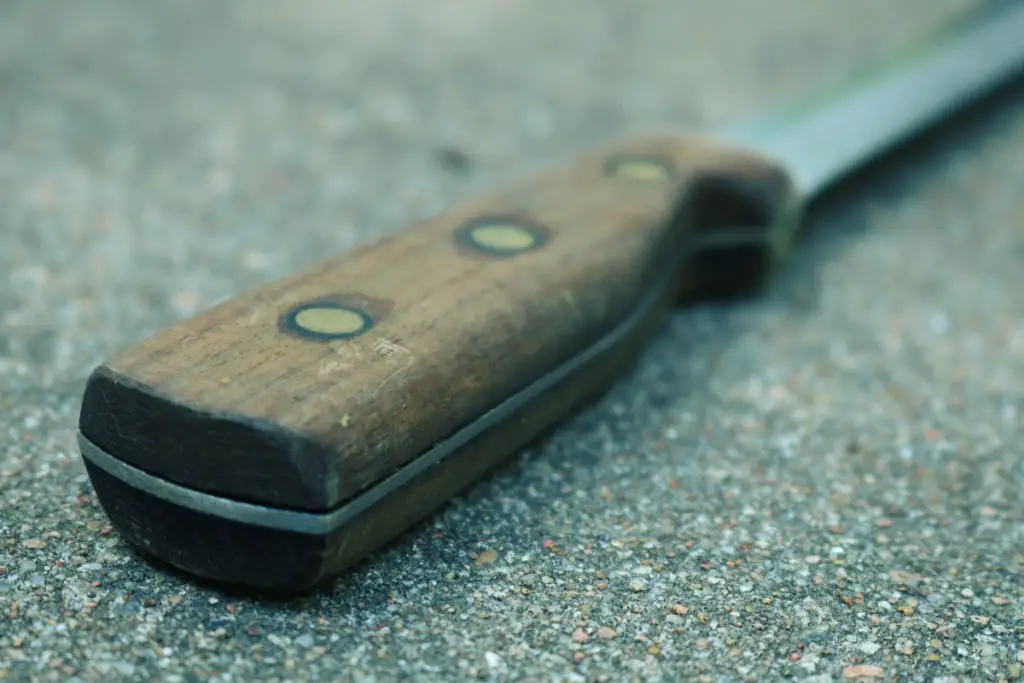
Bone
- Durability: 5/10
- Grip: 5/10
- Feel: 7/10
- Beauty: 9/10
Bone knife handles have been made since the dawn of man and continue to be very beautiful and popular. While they are far from the most durable or practical materials out there, they are absolute gems for collectors and very good for light-use knives.
Since bone is natural, over time it will crack and deteriorate. It is also very porous which makes it very susceptible to water damage and deformation. Bone is also known to be very slippery, especially when wet. This would not be ideal in survival or any other situation where you need precision and control over your knife. It is possible to texture the bone to make it more grippy and make it easier to keep a hold of.
Bone knife handles can be made quite beautiful and elegant. They can be engraved, dyed, and manipulated in all sorts of cool and beautiful ways. Overall, bone knife handles should be saved for the collector or the person that wants a beautiful knife but doesn’t need to do intensive tasks with it.
Wood
- Durability: 7/10
- Grip: 6/10
- Feel: 7/10
- Beauty: 9/10
By far the most popular natural knife handle material, wood can be a good survival knife option even with its many flaws. Wood as a knife handle can be quite beautiful, durable, and grippy. However, it involves a little bit of maintenance and of course the usual flaws of a natural material that is meant to decompose.
There are three main options for a wooden knife handle: softwoods, hardwoods, and stabilized woods. While all three would potentially work, they all have varying durability that makes only hardwood and stabilized wood good for survival knife handles.
Softwood comes mainly from various coniferous trees including pine, fir, and spruce. It is often less dense and will swell and deteriorate in humid climates. Hardwood comes from various deciduous trees including beech, oak, and walnut. Stabilized wood comes from hardwood trees that have been soaked in resin to make them more water-resistant and durable. Common brands of stabilized wood are Staminawood® and Dymondwood®.
Survival knife handles made of wood should generally be either hardwood or stabilized wood. This ensures that the handle is as durable as a wooden knife handle can be. However, no wood is completely waterproof and continual contact with water will inevitably lead to rot or cracking.
Wooden handles can be textured and engraved to improve the grip and feel of the handle. They can also be made quite beautiful through these texturing and engraving processes as well as dying the wood. Overall, wooden knife handles are not ideal for hardcore survival knives but can be great handles for everyday carry and light-use or decorative knives.
Leather
- Durability: 4/10
- Grip: 6/10
- Feel: 8/10
- Beauty: 8/10
Today there are very few all leather knife handles. Often, leather is used to accent wood, bone or other natural materials but is not the sole handle material. This is mainly due to the durability of the leather.
Leather is not very durable, and while you can occasionally find a knife that is just wrapped in leather for the handle, they are very rare and won’t last very long with regular usage. However, leather is very comfortable to hold and is surprisingly grippy when used as a knife handle material. It is also very traditional and holds a sort of elegant beauty that not many other handle materials have.
Leather accented knives tend to make just fine survival knife handles, but full leather handles should be shied away from. They simply do not have the needed durability that is necessary for a survival knife to possess.
Recap
Here’s a quick overview of everything covered in the article.
Metal Knife Handles:
- Stainless steel – durable, nice feel and grip, heavy
- Aluminum – durable, beautiful, good grip and feel, lightweight
- Titanium – very durable, lightweight, good feel and grip, expensive
Synthetic Knife Handles:
- G-10 – durable, good feel and grip, not beautiful
- Carbon fiber – durable, good feel and grip, very beautiful, expensive
- Paracord – not durable, good grip, bad feel, not beautiful
- Micarta® – durable, expensive, beautiful, good grip and feel
Natural Knife Handles:
- Bone – not durable, beautiful, bad grip and feel
- Wood – sort of durable, beautiful, good feel and grip
- Leather – not durable, good grip and feel, beautiful
So Which Material is Best?
Unfortunately, there is no clear winner.
I realize that I did not list off EVERY SINGLE MATERIAL out there, but I tried my best to cover the main and important ones.
Now I can confidently say what I would have liked to from the beginning. It all depends on your preferences and needs. There, I said it.
You’re probably saying to yourself, “But, that’s the easy answer to the question and it doesn’t help that much.” And you would be correct. However, I have armed you with a bunch of knowledge that will assist you in deciding the best survival knife handle material for you.
I like synthetic materials for my knife handles. I have found the most durability and success with those. But remember, that’s just me. You might, and probably don’t, have the same expectations and needs as I do.
So go out and find yourself a killer survival knife that has a handle that fits all your needs. And when you’re unsure of your choices or options, refer back to this article. It’ll be waiting.
